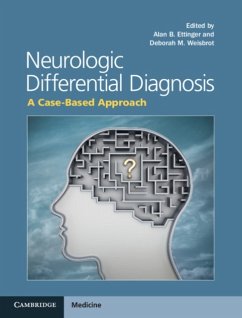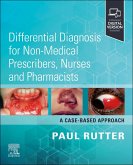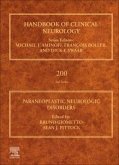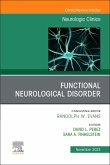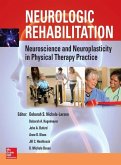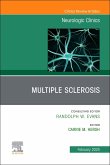Neurologic Differential Diagnosis
A Case-Based Approach
Herausgeber: Ettinger, Alan B; Weisbrot, Deborah M
Neurologic Differential Diagnosis
A Case-Based Approach
Herausgeber: Ettinger, Alan B; Weisbrot, Deborah M
- Gebundenes Buch
- Merkliste
- Auf die Merkliste
- Bewerten Bewerten
- Teilen
- Produkt teilen
- Produkterinnerung
- Produkterinnerung
"There is an apocryphal story of an eminent neurology professor who was asked to provide a differential diagnosis. He allegedly quipped: "I can't give you a differential diagnosis. If you wish I will give you a list of wrong diagnoses followed by the right diagnosis." Sadly, this sort of arrogance pervaded our field, particularly in the era before there were accurate diagnostic methods and effective treatments of neurological diseases. Fortunately, this sort of pomposity is now relegated to the past and remains only as an antique reminder of a type of hubris that precluded discovery and progress in diseases of the nervous system"--…mehr
Andere Kunden interessierten sich auch für
![Differential Diagnosis in Small Animal Cytology Differential Diagnosis in Small Animal Cytology]() Francesco Cian (UK BattLab)Differential Diagnosis in Small Animal Cytology64,99 €
Francesco Cian (UK BattLab)Differential Diagnosis in Small Animal Cytology64,99 €![Differential Diagnosis for Non-Medical Prescribers, Nurses and Pharmacists: A Case-Based Approach Differential Diagnosis for Non-Medical Prescribers, Nurses and Pharmacists: A Case-Based Approach]() Rutter, Paul, PhD, SFHEA (School of Professor in Pharmacy PracticeDifferential Diagnosis for Non-Medical Prescribers, Nurses and Pharmacists: A Case-Based Approach32,99 €
Rutter, Paul, PhD, SFHEA (School of Professor in Pharmacy PracticeDifferential Diagnosis for Non-Medical Prescribers, Nurses and Pharmacists: A Case-Based Approach32,99 €![Paraneoplastic Neurologic Disorders Paraneoplastic Neurologic Disorders]() Paraneoplastic Neurologic Disorders262,99 €
Paraneoplastic Neurologic Disorders262,99 €![Functional Neurological Disorder, an Issue of Neurologic Clinics Functional Neurological Disorder, an Issue of Neurologic Clinics]() Functional Neurological Disorder, an Issue of Neurologic Clinics104,99 €
Functional Neurological Disorder, an Issue of Neurologic Clinics104,99 €![Neurologic Rehabilitation: Neuroscience and Neuroplasticity in Physical Therapy Practice Neurologic Rehabilitation: Neuroscience and Neuroplasticity in Physical Therapy Practice]() Deborah S. Nichols LarsenNeurologic Rehabilitation: Neuroscience and Neuroplasticity in Physical Therapy Practice110,99 €
Deborah S. Nichols LarsenNeurologic Rehabilitation: Neuroscience and Neuroplasticity in Physical Therapy Practice110,99 €![Differential Diagnosis in Obstetrics & Gynaecology Differential Diagnosis in Obstetrics & Gynaecology]() Differential Diagnosis in Obstetrics & Gynaecology239,99 €
Differential Diagnosis in Obstetrics & Gynaecology239,99 €![Multiple Sclerosis, an Issue of Neurologic Clinics Multiple Sclerosis, an Issue of Neurologic Clinics]() Multiple Sclerosis, an Issue of Neurologic Clinics104,99 €
Multiple Sclerosis, an Issue of Neurologic Clinics104,99 €-
-
-
"There is an apocryphal story of an eminent neurology professor who was asked to provide a differential diagnosis. He allegedly quipped: "I can't give you a differential diagnosis. If you wish I will give you a list of wrong diagnoses followed by the right diagnosis." Sadly, this sort of arrogance pervaded our field, particularly in the era before there were accurate diagnostic methods and effective treatments of neurological diseases. Fortunately, this sort of pomposity is now relegated to the past and remains only as an antique reminder of a type of hubris that precluded discovery and progress in diseases of the nervous system"--
Hinweis: Dieser Artikel kann nur an eine deutsche Lieferadresse ausgeliefert werden.
Hinweis: Dieser Artikel kann nur an eine deutsche Lieferadresse ausgeliefert werden.
Produktdetails
- Produktdetails
- Verlag: Cambridge University Press
- Seitenzahl: 689
- Erscheinungstermin: 16. Juni 2014
- Englisch
- Abmessung: 254mm x 192mm x 38mm
- Gewicht: 1602g
- ISBN-13: 9781107014558
- ISBN-10: 1107014557
- Artikelnr.: 39495725
- Herstellerkennzeichnung
- Libri GmbH
- Europaallee 1
- 36244 Bad Hersfeld
- gpsr@libri.de
- Verlag: Cambridge University Press
- Seitenzahl: 689
- Erscheinungstermin: 16. Juni 2014
- Englisch
- Abmessung: 254mm x 192mm x 38mm
- Gewicht: 1602g
- ISBN-13: 9781107014558
- ISBN-10: 1107014557
- Artikelnr.: 39495725
- Herstellerkennzeichnung
- Libri GmbH
- Europaallee 1
- 36244 Bad Hersfeld
- gpsr@libri.de
Foreword
Preface
Part I. Differential Diagnosis of Abnormal Symptoms and Signs: 1. Introduction: localization and differential diagnosis in neurology
2. Agitation and aggressive behavior in patients with dementia or developmental disability
3. Agnosias
4. Anxiety and panic
5. Aphasia
6. Apraxia
7. Ataxia: subacute or chronic
8. Ataxia, acute, or subacute
9. Attentional problems
10. Autonomic failure or syndromes
11. Bulbar, pseudobulbar
12. Catatonic-like states
13. Chorea
14. Coma
15. Dementia
16. Depression and suicidal ideation
17. Diplopia
18. Dissociative disorder
19. Dizziness
20. Drop attacks
21. Dysarthria
22. Dysphagia
23. Dystonia
24. Eating disorders
25. Eye movements, abnormal
26. Falls
27. Foot drop
28. Gait abnormalities
29. Hallucinations, visual
30. Headache
31. Hearing deficit
32. Hypersomnolence
33. Incontinence
34. Mania and bipolar symptoms
35. Medically unexplained symptoms
36. Memory loss and cognitive decline, acute and subacute, amnesia
37. Mental status change, acute [and delirium]
38. Movement disorders in psychiatric disorders
39. Movement abnormalities in the face
40. Movements, focal, clonic
41. Movements, complex motor activity
42. Movements during sleep
43. Movements, tonic-clonic type
44. Mutism
45. Myalgia, cramps
46. Myoclonus
47. Myotonia
48. Nystagmus
49. Ophthalmoparesis, gaze conjugate lateral deficit and conjugate vertical deficit
50. Pain, eye
51. Pain, neck
52. Pain, arm
53. Pain, back
54. Pain, face
55. Papilledema
56. Paresthesias
57. Parkinson's Disease and related extrapyramidal syndromes
58. Proptosis [exophthalmos]
59. Psychosis, thought disorder
60. Ptosis
61. Pupil constriction and Horner's syndrome
62. Pupil dilatation
63. Respiratory difficulties, neurologic causes
64. Retardation, mental
65. Seizure
66. Sensory deficits and abnormal sensations
67. Sensory deficits in the face
68. Smell deficit
69. Spasm, hemifacial
70. Stroke and hemorrhage syndromes
71. Stroke in adults, etiologies
72. Stroke in the young, etiologies
73. Syncope
74. Tinnitus
75. Tremor
76. Vertigo
77. Visual loss, acute bilateral
78. Visual loss, monocular
79. Visual field deficits
80. Weakness, generalized acute
81. Weakness, hemiparesis
82. Weakness, proximal
83. Weakness, monomelic
84. Weakness, neck
85. Weakness, paraparesis
86. Weakness in ICU
Part II. Differential Diagnosis within Specific Localizations: 87. Cavernous sinus syndrome
88. Facial nerve palsy
89. Fourth nerve palsy
90. Myelopathy
91. Nerve, cranial: multiple deficit
92. Neuropathy, tibial
93. Neuropathy, femoral
94. Neuropathy, radial
95. Neuropathy, sciatic
96. Neuropathy, axonal versus demyelinating
97. Neuropathy, median and carpal tunnel
98. Neuropathy, ulnar
99. Plexopathy, brachial
100. Plexopathy, lumbar
101. Radiculopathy
102. Sixth nerve palsy
103. Third nerve palsy
Index.
Preface
Part I. Differential Diagnosis of Abnormal Symptoms and Signs: 1. Introduction: localization and differential diagnosis in neurology
2. Agitation and aggressive behavior in patients with dementia or developmental disability
3. Agnosias
4. Anxiety and panic
5. Aphasia
6. Apraxia
7. Ataxia: subacute or chronic
8. Ataxia, acute, or subacute
9. Attentional problems
10. Autonomic failure or syndromes
11. Bulbar, pseudobulbar
12. Catatonic-like states
13. Chorea
14. Coma
15. Dementia
16. Depression and suicidal ideation
17. Diplopia
18. Dissociative disorder
19. Dizziness
20. Drop attacks
21. Dysarthria
22. Dysphagia
23. Dystonia
24. Eating disorders
25. Eye movements, abnormal
26. Falls
27. Foot drop
28. Gait abnormalities
29. Hallucinations, visual
30. Headache
31. Hearing deficit
32. Hypersomnolence
33. Incontinence
34. Mania and bipolar symptoms
35. Medically unexplained symptoms
36. Memory loss and cognitive decline, acute and subacute, amnesia
37. Mental status change, acute [and delirium]
38. Movement disorders in psychiatric disorders
39. Movement abnormalities in the face
40. Movements, focal, clonic
41. Movements, complex motor activity
42. Movements during sleep
43. Movements, tonic-clonic type
44. Mutism
45. Myalgia, cramps
46. Myoclonus
47. Myotonia
48. Nystagmus
49. Ophthalmoparesis, gaze conjugate lateral deficit and conjugate vertical deficit
50. Pain, eye
51. Pain, neck
52. Pain, arm
53. Pain, back
54. Pain, face
55. Papilledema
56. Paresthesias
57. Parkinson's Disease and related extrapyramidal syndromes
58. Proptosis [exophthalmos]
59. Psychosis, thought disorder
60. Ptosis
61. Pupil constriction and Horner's syndrome
62. Pupil dilatation
63. Respiratory difficulties, neurologic causes
64. Retardation, mental
65. Seizure
66. Sensory deficits and abnormal sensations
67. Sensory deficits in the face
68. Smell deficit
69. Spasm, hemifacial
70. Stroke and hemorrhage syndromes
71. Stroke in adults, etiologies
72. Stroke in the young, etiologies
73. Syncope
74. Tinnitus
75. Tremor
76. Vertigo
77. Visual loss, acute bilateral
78. Visual loss, monocular
79. Visual field deficits
80. Weakness, generalized acute
81. Weakness, hemiparesis
82. Weakness, proximal
83. Weakness, monomelic
84. Weakness, neck
85. Weakness, paraparesis
86. Weakness in ICU
Part II. Differential Diagnosis within Specific Localizations: 87. Cavernous sinus syndrome
88. Facial nerve palsy
89. Fourth nerve palsy
90. Myelopathy
91. Nerve, cranial: multiple deficit
92. Neuropathy, tibial
93. Neuropathy, femoral
94. Neuropathy, radial
95. Neuropathy, sciatic
96. Neuropathy, axonal versus demyelinating
97. Neuropathy, median and carpal tunnel
98. Neuropathy, ulnar
99. Plexopathy, brachial
100. Plexopathy, lumbar
101. Radiculopathy
102. Sixth nerve palsy
103. Third nerve palsy
Index.
Foreword
Preface
Part I. Differential Diagnosis of Abnormal Symptoms and Signs: 1. Introduction: localization and differential diagnosis in neurology
2. Agitation and aggressive behavior in patients with dementia or developmental disability
3. Agnosias
4. Anxiety and panic
5. Aphasia
6. Apraxia
7. Ataxia: subacute or chronic
8. Ataxia, acute, or subacute
9. Attentional problems
10. Autonomic failure or syndromes
11. Bulbar, pseudobulbar
12. Catatonic-like states
13. Chorea
14. Coma
15. Dementia
16. Depression and suicidal ideation
17. Diplopia
18. Dissociative disorder
19. Dizziness
20. Drop attacks
21. Dysarthria
22. Dysphagia
23. Dystonia
24. Eating disorders
25. Eye movements, abnormal
26. Falls
27. Foot drop
28. Gait abnormalities
29. Hallucinations, visual
30. Headache
31. Hearing deficit
32. Hypersomnolence
33. Incontinence
34. Mania and bipolar symptoms
35. Medically unexplained symptoms
36. Memory loss and cognitive decline, acute and subacute, amnesia
37. Mental status change, acute [and delirium]
38. Movement disorders in psychiatric disorders
39. Movement abnormalities in the face
40. Movements, focal, clonic
41. Movements, complex motor activity
42. Movements during sleep
43. Movements, tonic-clonic type
44. Mutism
45. Myalgia, cramps
46. Myoclonus
47. Myotonia
48. Nystagmus
49. Ophthalmoparesis, gaze conjugate lateral deficit and conjugate vertical deficit
50. Pain, eye
51. Pain, neck
52. Pain, arm
53. Pain, back
54. Pain, face
55. Papilledema
56. Paresthesias
57. Parkinson's Disease and related extrapyramidal syndromes
58. Proptosis [exophthalmos]
59. Psychosis, thought disorder
60. Ptosis
61. Pupil constriction and Horner's syndrome
62. Pupil dilatation
63. Respiratory difficulties, neurologic causes
64. Retardation, mental
65. Seizure
66. Sensory deficits and abnormal sensations
67. Sensory deficits in the face
68. Smell deficit
69. Spasm, hemifacial
70. Stroke and hemorrhage syndromes
71. Stroke in adults, etiologies
72. Stroke in the young, etiologies
73. Syncope
74. Tinnitus
75. Tremor
76. Vertigo
77. Visual loss, acute bilateral
78. Visual loss, monocular
79. Visual field deficits
80. Weakness, generalized acute
81. Weakness, hemiparesis
82. Weakness, proximal
83. Weakness, monomelic
84. Weakness, neck
85. Weakness, paraparesis
86. Weakness in ICU
Part II. Differential Diagnosis within Specific Localizations: 87. Cavernous sinus syndrome
88. Facial nerve palsy
89. Fourth nerve palsy
90. Myelopathy
91. Nerve, cranial: multiple deficit
92. Neuropathy, tibial
93. Neuropathy, femoral
94. Neuropathy, radial
95. Neuropathy, sciatic
96. Neuropathy, axonal versus demyelinating
97. Neuropathy, median and carpal tunnel
98. Neuropathy, ulnar
99. Plexopathy, brachial
100. Plexopathy, lumbar
101. Radiculopathy
102. Sixth nerve palsy
103. Third nerve palsy
Index.
Preface
Part I. Differential Diagnosis of Abnormal Symptoms and Signs: 1. Introduction: localization and differential diagnosis in neurology
2. Agitation and aggressive behavior in patients with dementia or developmental disability
3. Agnosias
4. Anxiety and panic
5. Aphasia
6. Apraxia
7. Ataxia: subacute or chronic
8. Ataxia, acute, or subacute
9. Attentional problems
10. Autonomic failure or syndromes
11. Bulbar, pseudobulbar
12. Catatonic-like states
13. Chorea
14. Coma
15. Dementia
16. Depression and suicidal ideation
17. Diplopia
18. Dissociative disorder
19. Dizziness
20. Drop attacks
21. Dysarthria
22. Dysphagia
23. Dystonia
24. Eating disorders
25. Eye movements, abnormal
26. Falls
27. Foot drop
28. Gait abnormalities
29. Hallucinations, visual
30. Headache
31. Hearing deficit
32. Hypersomnolence
33. Incontinence
34. Mania and bipolar symptoms
35. Medically unexplained symptoms
36. Memory loss and cognitive decline, acute and subacute, amnesia
37. Mental status change, acute [and delirium]
38. Movement disorders in psychiatric disorders
39. Movement abnormalities in the face
40. Movements, focal, clonic
41. Movements, complex motor activity
42. Movements during sleep
43. Movements, tonic-clonic type
44. Mutism
45. Myalgia, cramps
46. Myoclonus
47. Myotonia
48. Nystagmus
49. Ophthalmoparesis, gaze conjugate lateral deficit and conjugate vertical deficit
50. Pain, eye
51. Pain, neck
52. Pain, arm
53. Pain, back
54. Pain, face
55. Papilledema
56. Paresthesias
57. Parkinson's Disease and related extrapyramidal syndromes
58. Proptosis [exophthalmos]
59. Psychosis, thought disorder
60. Ptosis
61. Pupil constriction and Horner's syndrome
62. Pupil dilatation
63. Respiratory difficulties, neurologic causes
64. Retardation, mental
65. Seizure
66. Sensory deficits and abnormal sensations
67. Sensory deficits in the face
68. Smell deficit
69. Spasm, hemifacial
70. Stroke and hemorrhage syndromes
71. Stroke in adults, etiologies
72. Stroke in the young, etiologies
73. Syncope
74. Tinnitus
75. Tremor
76. Vertigo
77. Visual loss, acute bilateral
78. Visual loss, monocular
79. Visual field deficits
80. Weakness, generalized acute
81. Weakness, hemiparesis
82. Weakness, proximal
83. Weakness, monomelic
84. Weakness, neck
85. Weakness, paraparesis
86. Weakness in ICU
Part II. Differential Diagnosis within Specific Localizations: 87. Cavernous sinus syndrome
88. Facial nerve palsy
89. Fourth nerve palsy
90. Myelopathy
91. Nerve, cranial: multiple deficit
92. Neuropathy, tibial
93. Neuropathy, femoral
94. Neuropathy, radial
95. Neuropathy, sciatic
96. Neuropathy, axonal versus demyelinating
97. Neuropathy, median and carpal tunnel
98. Neuropathy, ulnar
99. Plexopathy, brachial
100. Plexopathy, lumbar
101. Radiculopathy
102. Sixth nerve palsy
103. Third nerve palsy
Index.

